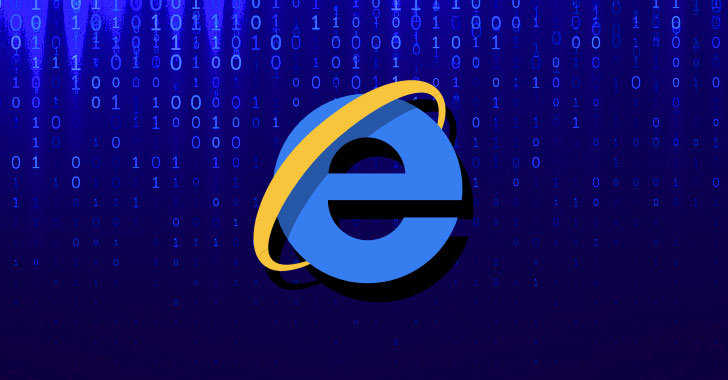Internet Explorer is dead, but not the mess it left behind.
Microsoft earlier today issued an emergency security advisory warning millions of Windows users of a new zero-day vulnerability in Internet Explorer (IE) browser that attackers are actively exploiting in the wild — and there is no patch yet available for it.
The vulnerability, tracked as CVE-2020-0674 and rated moderated, is a remote code execution issue that exists in the way the scripting engine handles objects in memory of Internet Explorer and triggers through JScript.dll library.
A remote attacker can execute arbitrary code on targeted computers and take full control over them just by convincing victims into opening a maliciously crafted web page on the vulnerable Microsoft browser.
"The vulnerability could corrupt memory in such a way that an attacker could execute arbitrary code in the context of the current user. An attacker who successfully exploited the vulnerability could gain the same user rights as the current user," the advisory says.
"If the current user is logged on with administrative user rights, an attacker who successfully exploited the vulnerability could take control of an affected system. An attacker could then install programs; view, change, or delete data; or create new accounts with full user rights."
Microsoft is aware of 'limited targeted attacks' in the wild and working on a fix, but until a patch is released, affected users have been provided with workarounds and mitigation to prevent their vulnerable systems from cyberattacks.
The affected web browsing software includes — Internet Explorer 9, Internet Explorer 10, and Internet Explorer 11 running on all versions of Windows 10, Windows 8.1, and the recently-discontinued Windows 7.
According to the advisory, preventing the loading of the JScript.dll library can manually block the exploitation of this vulnerability.
To restrict access to JScript.dll, run following commands on your Windows system with administrator privileges.
For 32-bit systems:
For 64-bit systems:
When a patch update is available, users need to undo the workaround using the following commands:
For 32-bit systems:
For 64-bit systems:
To be noted, some websites or features may break after disabling the vulnerable JScript.dll library that relies on this component, therefore, users should install updates as soon as they become available.
Microsoft earlier today issued an emergency security advisory warning millions of Windows users of a new zero-day vulnerability in Internet Explorer (IE) browser that attackers are actively exploiting in the wild — and there is no patch yet available for it.
The vulnerability, tracked as CVE-2020-0674 and rated moderated, is a remote code execution issue that exists in the way the scripting engine handles objects in memory of Internet Explorer and triggers through JScript.dll library.
A remote attacker can execute arbitrary code on targeted computers and take full control over them just by convincing victims into opening a maliciously crafted web page on the vulnerable Microsoft browser.
"The vulnerability could corrupt memory in such a way that an attacker could execute arbitrary code in the context of the current user. An attacker who successfully exploited the vulnerability could gain the same user rights as the current user," the advisory says.
"If the current user is logged on with administrative user rights, an attacker who successfully exploited the vulnerability could take control of an affected system. An attacker could then install programs; view, change, or delete data; or create new accounts with full user rights."
Microsoft is aware of 'limited targeted attacks' in the wild and working on a fix, but until a patch is released, affected users have been provided with workarounds and mitigation to prevent their vulnerable systems from cyberattacks.
The affected web browsing software includes — Internet Explorer 9, Internet Explorer 10, and Internet Explorer 11 running on all versions of Windows 10, Windows 8.1, and the recently-discontinued Windows 7.
Workarounds: Defend Against Attacks Until A Patch Arrives
According to the advisory, preventing the loading of the JScript.dll library can manually block the exploitation of this vulnerability.
To restrict access to JScript.dll, run following commands on your Windows system with administrator privileges.
For 32-bit systems:
takeown / f% windir% \ system32 \ jscript.dll
cacls% windir% \ system32 \ jscript.dll / E / P everyone: N
For 64-bit systems:
takeown / f% windir% \ syswow64 \ jscript.dll
cacls% windir% \ syswow64 \ jscript.dll / E / P everyone: N
takeown / f% windir% \ system32 \ jscript.dll
cacls% windir% \ system32 \ jscript.dll / E / P everyone: N
When a patch update is available, users need to undo the workaround using the following commands:
For 32-bit systems:
cacls %windir%\system32\jscript.dll /E /R everyone
For 64-bit systems:
cacls %windir%\system32\jscript.dll /E /R everyone
cacls %windir%\syswow64\jscript.dll /E /R everyone
To be noted, some websites or features may break after disabling the vulnerable JScript.dll library that relies on this component, therefore, users should install updates as soon as they become available.
Have something to say about this article? Comment below or share it with us on Facebook, Twitter or our LinkedIn Group.
